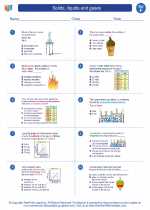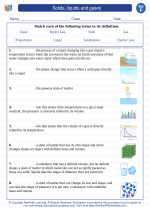Fossil Fuels
Fossil fuels are natural resources that are formed from the remains of ancient plants and animals. Over millions of years, the remains are transformed by heat and pressure into coal, oil, and natural gas. These fuels are non-renewable, meaning they cannot be easily replaced once they are used up.
Types of Fossil Fuels:
- Coal: Formed from the remains of plants that lived in swamps millions of years ago. There are different types of coal, including lignite, bituminous, and anthracite.
- Oil (Petroleum): Formed from the remains of marine plants and animals. It is found in underground reservoirs and is extracted through drilling.
- Natural Gas: Formed from the same type of organic material as oil, but it is in the gaseous state at room temperature. It is often found in association with oil deposits.
Uses of Fossil Fuels:
Fossil fuels are used for a variety of purposes, including:
- Electricity generation
- Transportation (e.g., gasoline and diesel for cars, trucks, and airplanes)
- Heating and cooling buildings
- Manufacturing processes
Environmental Impact:
While fossil fuels have been essential for human development, their use has also led to environmental issues such as air and water pollution, greenhouse gas emissions, and habitat destruction.
Study Guide Questions:
- What are fossil fuels and how are they formed?
- List and describe the three main types of fossil fuels.
- Explain the uses of fossil fuels in modern society.
- What are the environmental impacts of using fossil fuels?
- Why are fossil fuels considered non-renewable resources?
[Fossil Fuels] Related Worksheets and Study Guides:
.◂Science Worksheets and Study Guides Sixth Grade. Solids, liquids and gases
Study Guide Solids, liquids and gases
Solids, liquids and gases  Activity Lesson
Activity Lesson Solids, Liquids & Gases
Solids, Liquids & Gases  Worksheet/Answer key
Worksheet/Answer key Solids, liquids and gases
Solids, liquids and gases  Worksheet/Answer key
Worksheet/Answer key Solids, liquids and gases
Solids, liquids and gases  Worksheet/Answer key
Worksheet/Answer key Solids, liquids and gases
Solids, liquids and gases  Vocabulary/Answer key
Vocabulary/Answer key Solids, liquids and gases
Solids, liquids and gases  Vocabulary/Answer key
Vocabulary/Answer key Solids, liquids and gases
Solids, liquids and gases 

 Activity Lesson
Activity Lesson
 Worksheet/Answer key
Worksheet/Answer key
 Worksheet/Answer key
Worksheet/Answer key
 Worksheet/Answer key
Worksheet/Answer key
 Vocabulary/Answer key
Vocabulary/Answer key
 Vocabulary/Answer key
Vocabulary/Answer key

The resources above cover the following skills:
PHYSICAL SCIENCE
Energy
Students who demonstrate understanding can:
Plan an investigation to determine the relationships among the energy transferred, the type of matter, the mass, and the change in the average kinetic energy of the particles as measured by the temperature of the sample.